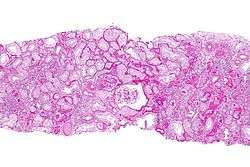Chronic allograft nephropathy
| Chronic allograft nephropathy | |
|---|---|
|
Micrograph of chronic allograft nephropathy. PAS stain. | |
| Classification and external resources |
Chronic allograft nephropathy, abbreviated CAN and also known as sclerosing/chronic allograft nephropathy, is the leading cause of kidney transplant failure[1] and happens month to years after the transplant.
Symptoms
CAN is characterized by a gradual decline in kidney function and, typically, accompanied by high blood pressure and hematuria.[2]
Diagnosis
CAN is diagnosed by examination of tissue, e.g. a kidney biopsy.
Pathology
The histopathology is characterized by interstitial fibrosis, tubular atrophy, fibrotic intimal thickening of arteries and glomerulosclerosis.[2][3]
References
- ↑ Paul, LC. (Sep 1999). "Chronic allograft nephropathy: An update.". Kidney Int. 56 (3): 783–93. doi:10.1046/j.1523-1755.1999.00611.x. PMID 10469349.
- 1 2 Joosten, SA.; Sijpkens, YW.; van Kooten, C.; Paul, LC. (Jul 2005). "Chronic renal allograft rejection: pathophysiologic considerations.". Kidney Int. 68 (1): 1–13. doi:10.1111/j.1523-1755.2005.00376.x. PMID 15954891.
- ↑ Nankivell, BJ.; Chapman, JR. (Mar 2006). "Chronic allograft nephropathy: current concepts and future directions.". Transplantation. 81 (5): 643–54. doi:10.1097/01.tp.0000190423.82154.01. PMID 16534463.
This article is issued from Wikipedia - version of the 3/7/2016. The text is available under the Creative Commons Attribution/Share Alike but additional terms may apply for the media files.
